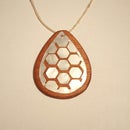Introduction: Micro Test Tube Dioramas (Smaller Than a Penny)
In this Instructable, I will be showing you how to create Micro Dioramas in test tubes. The dioramas I made are actually smaller in diameter than a penny!
I got inspiration for this project from Amsterdam based artist Rosa de Jong and her creation of “Micro Matter”. Her creations are absolutely wonderful, however I want to say that mine are actually much much smaller than hers. Hers are 1⅛ (1.125 inches) and mine are ¾ (0.75 inches), meaning that mine are 60% the size of hers. That is a 40% decrease in size, which is huge at such a miniature scale.
I made 3 different dioramas each in a slightly different scale, with a wooden geometric base to go with it. They took so much time, and were so meticulous and frustrating at times, but I love the way they turned out, and am super happy with how detailed they are!
Materials:
• Test tubes
• Sturdy Paper
• Clay
• Acrylic Paint
• Wood Stain
• Coffee stirrers and popsicle sticks
• Diorama Vegetation (flocking and bushes)
Tools:
• Xacto
• Mod Podge
• Cyanoacrylate glue (super glue)
• Hot Glue
Step 1: Making the Base
Step 2: Making the Models
The water tower is made primarily out of coffee stirrers, as well as a small plastic disk for the base of the tank, and also paper for the roof. I started by cutting thin 1mm by 1mm strips from a coffee stirrer, and shaved them down until they were the proper size. I then made 3 large poles out of it, and added 8 other strips of wood to connect the entire thing together and make the base. I then started on the water tank, by painting the small plastic circle black. I then took thin strips of wood from the coffee stirrer, and glued them on top of the plastic circle. Next I took a bit of paper and glued it into a short cone shape to serve as a roof. The last step in the construction of this was to glue the water tank to the tower base, and for that I used cyanoacrylate glue, just like everything else so far in the tower.
Stone Head
I modeled this diorama after the Stone Heads in Easter Island. To create this head, I hand sculpted the piece out of porcelain clay, and meticulously modeled it so that is incredibly accurate to how the actual heads on Easter Island look. I had to let the head dry, and once it did, I mounted it to the base using cyanoacrylate glue, and moved on the the next diorama.
Stonehenge
For my mock stonehenge, it is made of coffee stirrers carved down to around 1mm by 1mm. I cut out tiny lengths of the wood and arranged them in arches, then arranged the arches into a rough circle shape. Everything is held together using cyanoacrylate glue so far in this model.
Step 3: Paint and Stain
On both the stone head and Stonehenge I painted them with gray primer, then used a light black wash to add some depth and detail into the pieces. I made the wash by adding a bit of water into black acrylic paint to make it less viscous, then painted it all over the models, then gently wiped it away. The trick to using washes is letting the paint sit on the pieces for a short time, and allow capillary action to pull the wash into the cracks so that it can’t be wiped away, then wipe away most of it. I absolutely love the way the black wash looked on the sculpted stone head, and I think it really made it look more like stone.
Step 4: Flocking & Foliage
I applied extra foliage in the form of little bushes to add some more detail and an overgrown look to all the pieces. I placed them very sparingly, but they really helped complete the overgrown look I wanted on all of the pieces.
I got all of the faux foliage from a diorama kit I had sitting in my basement for years that I never got around to making. You can find these in most craft stores, and very easily online.
Step 5: Adding Faux Soil and Roots
Step 6: Installing Into the Test Tubes
Step 7: Making the Wooden Base
Step 8: Final Thoughts
If you like this project, please vote for me in the contests this is submitted into, and also check out my other Instructables!
Thank you!
Brandon (16)

Runner Up in the
Woodworking Contest 2017

Runner Up in the
Glass Challenge 2017











